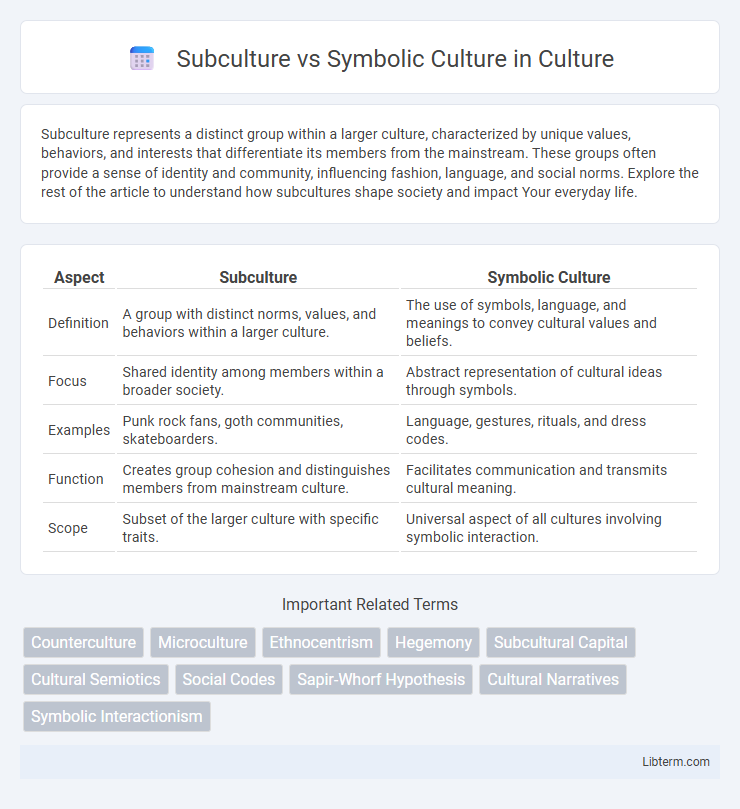Subculture represents a distinct group within a larger culture, characterized by unique values, behaviors, and interests that differentiate its members from the mainstream. These groups often provide a sense of identity and community, influencing fashion, language, and social norms. Explore the rest of the article to understand how subcultures shape society and impact Your everyday life.
Table of Comparison
| Aspect | Subculture | Symbolic Culture |
|---|---|---|
| Definition | A group with distinct norms, values, and behaviors within a larger culture. | The use of symbols, language, and meanings to convey cultural values and beliefs. |
| Focus | Shared identity among members within a broader society. | Abstract representation of cultural ideas through symbols. |
| Examples | Punk rock fans, goth communities, skateboarders. | Language, gestures, rituals, and dress codes. |
| Function | Creates group cohesion and distinguishes members from mainstream culture. | Facilitates communication and transmits cultural meaning. |
| Scope | Subset of the larger culture with specific traits. | Universal aspect of all cultures involving symbolic interaction. |
Defining Subculture: Key Characteristics
Subculture is defined by its distinct values, norms, and practices that differentiate its members from the dominant culture while coexisting within the larger society. Key characteristics include a unique language or jargon, shared beliefs or interests, and specialized behaviors that create a sense of identity and belonging. Unlike symbolic culture, which encompasses the broader use of symbols and norms across society, subcultures specifically embody a subset with identifiable cultural variations.
Understanding Symbolic Culture: An Overview
Symbolic culture encompasses the non-material aspects of culture, including language, beliefs, values, norms, and rituals that shape social interactions and shared meanings within a society. It contrasts with subculture, which represents distinct groups within a larger culture having unique symbols, values, and norms that differentiate them from the dominant culture while still engaging with its symbolic framework. Understanding symbolic culture requires analyzing how symbols and meanings create social cohesion and influence cultural identity across diverse communities.
Origins and Development of Subcultures
Subcultures originate from shared values, interests, or social experiences that differentiate a group from the dominant culture, often emerging as a response to social, economic, or political conditions. The development of subcultures involves unique norms, language, and styles that create a distinct identity while maintaining symbolic ties to the larger culture through symbols, rituals, and meanings. Symbolic culture, encompassing language, beliefs, and non-material elements, provides the foundation upon which subcultures construct their specialized symbols and practices for group cohesion and social distinction.
The Role of Symbols in Culture
Symbols in symbolic culture serve as the foundational elements that convey shared meanings, values, and norms within a society, enabling communication beyond verbal language. Subcultures develop their own distinctive symbols, such as styles, language, and rituals, to express unique identities and differentiate themselves from the dominant culture. These symbols facilitate group cohesion and transmit cultural heritage while reflecting the dynamic interaction between mainstream and subcultural groups.
Subculture vs Symbolic Culture: Core Differences
Subculture consists of a group within a larger society that shares distinct values, norms, and behaviors differing from the mainstream culture, often forming unique identities based on shared interests or experiences. Symbolic culture refers to the non-material aspects of culture, such as language, symbols, rituals, and beliefs, that convey meaning and facilitate communication within a society. Core differences lie in subculture's focus on tangible social groups with specific lifestyles, whereas symbolic culture emphasizes abstract symbols and meanings that shape collective understanding.
How Subcultures Shape Identity
Subcultures shape identity by fostering distinct values, norms, and behaviors that differentiate members from the dominant symbolic culture. These groups provide individuals with a sense of belonging and self-expression through shared practices, language, and symbols unique to the subculture. The interaction between subcultural affiliation and symbolic culture influences how individuals negotiate their social identity within broader society.
Symbolic Culture and Social Meaning
Symbolic culture encompasses the intangible elements of culture such as language, beliefs, norms, values, and symbols that carry social meaning and guide human behavior. Unlike subcultures, which are distinct groups within a larger culture with unique practices, symbolic culture forms the foundational framework that shapes collective identity and social cohesion. The social meanings embedded in symbols like gestures, rituals, and language enable individuals to communicate, interpret experiences, and maintain cultural continuity across generations.
Interaction Between Subculture and Symbolic Culture
Subcultures develop unique practices, values, and symbols that both shape and are shaped by the broader symbolic culture within a society. Interaction between subculture and symbolic culture occurs through the reinterpretation and renegotiation of symbols, where subcultures challenge or transform dominant meanings to express distinct identities. This dynamic process fosters cultural diversity, influencing mainstream symbols and contributing to social change.
Examples of Subcultures and Their Symbols
Goth subculture is characterized by dark clothing, makeup, and symbols like ankh crosses and skulls that represent themes of mystery and mortality. Skateboarder subculture uses symbols such as branded decks, Vans shoes, and graffiti art to convey rebellion and urban street style. The hippie subculture embraces peace signs, floral patterns, and tie-dye clothing as symbols reflecting ideals of love, freedom, and anti-establishment values.
The Cultural Impact of Subcultures and Symbols
Subcultures shape cultural diversity by creating distinct values and norms within larger societies, influencing fashion, music, and language that often challenge mainstream culture. Symbolic culture, consisting of shared symbols like language, gestures, and rituals, facilitates communication and cultural identity across different groups. The cultural impact of subcultures and symbols lies in their power to both unify communities and drive social change through meaningful representation and expression.
Subculture Infographic

 libterm.com
libterm.com